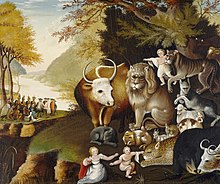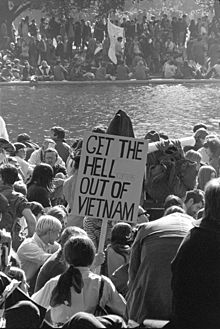Pacifism in the United States
Pacifism has manifested in the United States in a variety of forms (such as peace movements), and in myriad contexts (such as opposition to the Civil War and to nuclear weapons).
They controlled Pennsylvania politics until they refused to fight the native Americans who were allied with the French enemy and attacking frontier farms.
Quaker intellectuals and activists played a major role in developing an anti-war Peace Position and spreading the word in the new nation.
[6][7] Opposition to the War of 1812 was strongest in New England, which conducted significant amounts of trade with the British Empire, and weakest in the Southern United States.
In the ensuing 1812 and 1813 United States House of Representatives elections, eight sitting New England congressmen were rejected by the voters, and several others saw the writing on the wall and declined to seek re-election.
The groups merged into the American Peace Society, which held weekly meetings and produced literature that was spread as far as Gibraltar and Malta describing the horrors of war and advocating pacifism on Christian grounds.
With the Confederate artillery attack on Fort Sumter in April 1861, the mood in the North decisively changed, bringing a hyperpatriotic emphasis on defending the United States in the name of American nationalism.
In 1911 Taft and his Secretary of State Philander C. Knox negotiated major treaties with Britain and with France providing that differences be arbitrated.
However, an opposing faction of progressives, led by ex-president Theodore Roosevelt, ridiculed arbitration as foolhardy idealism, and insisted on the realism of warfare as the only solution to serious disputes.
Roosevelt worked with his close friend Senator Henry Cabot Lodge to impose those amendments that ruined the goals of the treaties.
These included a settlement of the boundary between Maine and New Brunswick, a long-running dispute over seal hunting in the Bering Sea that also involved Japan, and a similar disagreement regarding fishing off Newfoundland.
[23] There is less on opposition in 1917-1918, and focuses on repression of the antiwar left by the government[24] On women see [25][26] see: Warren F. Kuehl, and Lynne Dunn, Keeping the covenant: American internationalists and the League of Nations, 1920-1939 (Kent State University Press, 1997).
While many peace activists in the 1920s were disappointed that the U.S. never joined the League of Nations of the World Court, they did support American leadership in achieving a major reduction in naval weapons among the leading powers.
[30] The Washington Naval Conference convened in November 1921, with representatives from the U.S., Japan, Britain, France, Italy, China, Belgium, the Netherlands, and Portugal—but not Germany (which had no navy) or the Soviet Union.
A journalist covering the conference wrote that "Hughes sank in thirty-five minutes more ships than all of the admirals of the world have sunk in a cycle of centuries.
The United States, Britain, Japan, and France reached the Four-Power Treaty, in which each country agreed to respect the territorial integrity of one another in the Pacific Ocean.
Those four powers as well as Italy also reached the Washington Naval Treaty, which established a ratio of battleship tonnage that each country agreed to respect.
The building of "monster warships" resumed and the U.S. and Great Britain were unable to quickly rearm themselves to defend an international order and stop Japan from remilitarizing.
[47] The Communist Party opposed American involvement in the early stages of World War II, starting in August 1939, when the Molotov–Ribbentrop Pact launched a deal between Stalin and Hitler that allowed Moscow to split control of Eastern Europe with Berlin.
Leftist organizations like the American Peace Mobilization and veterans of the Abraham Lincoln Brigade protested in opposition to the war, the draft, and the Lend-Lease Act.
They said of Lend-Lease, "Roosevelt needs its dictatorial powers to further his aim of carving out of a warring world, the American Empire so long desired by the Wall Street money lords.
[49] Numerous women activists, notably within the Mothers' movement led by Elizabeth Dilling, opposed American involvement on the basis that it would be preferable for Nazism rather than Communism to dominate Europe.
[51] Father Charles Coughlin urged the US to keep out of the war and permit Germany to conquer Great Britain and the Soviet Union.
US Senator Gerald Nye from North Dakota would even blame the Great Depression on America's economic expansion during World War I.
The isolationists, led by the America First Committee, were a large, vocal, and powerful challenge to President Roosevelt's efforts to enter the war.
News reports of American military abuses such as the 1968 My Lai massacre brought attention (and support) to the anti-war movement, which continued to expand for the duration of the conflict.
Outreach to individual citizens in the Soviet Union and mass meetings using satellite-link technology were major parts of peacemaking activity during the 1980s.
Peace activists were starting to gain traction with popular rallies, especially on the West Coast, just before the Gulf War began in February 1991.
The ground war ended in less than a week with a lopsided Allied victory, and a media-incited wave of patriotic sentiment washed over the nascent protest movement.
[62] During the 1990s, peacemaker priorities included seeking a solution to the Israeli–Palestinian impasse, humanitarian assistance to war-torn regions such as Bosnia and Rwanda, and aid to post-war Iraq.




